
Browse an alphabetical list of photographs. These historical images portray people, places, and events before, during, and after World War II and the Holocaust.
<< Previous | Displaying results 126-150 of 2641 for "Photo" | Next >>
A US soldier stands among the corpses of prisoners exhumed from a mass grave in a ravine near Nammering. On April 19, 1945, a freight train with nearly 4,500 prisoners from Buchenwald pulled onto the railroad siding at Nammering. Hundreds of prisoners who had died on the train were buried in the mass grave along with the prisoners who were forced to carry the corpses to the ravine and were then shot. Germany, ca. May 6, 1945.

Following the Axis invasion of Yugoslavia in April 1941, Hungarian authorities in Novi Sad began confiscating property from Jewish families. The city's synagogue served as a warehouse for the stolen goods.
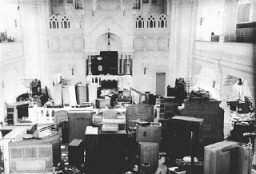
A victim of a Nazi medical experiment is immersed in icy water at the Dachau concentration camp. SS doctor Sigmund Rascher oversees the experiment. Germany, 1942.
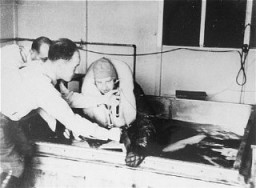
A victim of the Nazi Euthanasia Program. Hospitalized in a psychiatric ward for her nonconformist beliefs and writings, she was murdered on January 26, 1944. Germany, date uncertain.
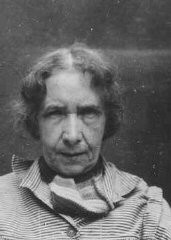
A view of barracks in the Stutthof concentration camp. This photograph was taken after the liberation of the camp. Stutthof, near Danzig, 1945.
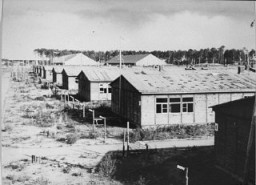
A visitor stands in front of the quotation from Martin Niemöller that is on display in the Permanent Exhibition of the United States Holocaust Memorial Museum. Niemöller was a Lutheran minister and early Nazi supporter who was later imprisoned for opposing Hitler's regime.
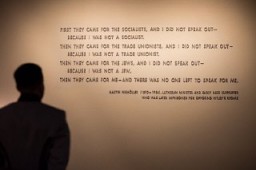
One of many warehouses at Auschwitz in which the Germans stored clothing belonging taken from victims of the camp. This photograph was taken after the liberation of the camp. Auschwitz, Poland, after January 1945.
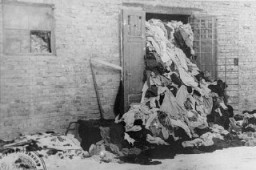
A watchtower and barracks at the Ohrdruf subcamp of the Buchenwald concentration camp. This photograph was taken after the US 4th Armored Division liberated the camp. Ohrdruf, Germany, June 1945.
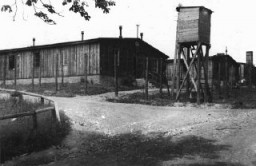
A witness testifies during the Mauthausen concentration camp trial. The man standing in the background is defendant Willy Eckert, a member of the SS. The trial took place before an American Military Tribunal in Dachau, Germany. March-May 1936.
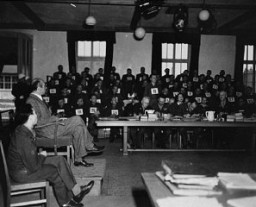
At an American military tribunal held in Dachau, a witness for the prosecution identifies a doctor who had denied medical care to prisoners at the Dora-Mittelbau concentration camp. Dachau, Germany, 1947.
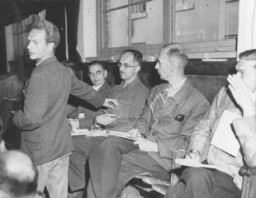
Friedrich Hoffman, holding a stack of death records, testifies about the murder of 324 Catholic priests who were exposed to malaria during Nazi medical experiments at the Dachau concentration camp. Dachau, Germany, November 22, 1945.
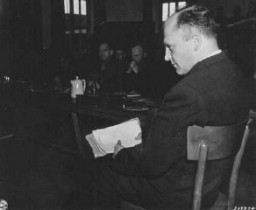
A wounded partisan is treated in a field hospital belonging to the Shish detachment of the Molotov brigade. Among those pictured are Dr. Ivan Khudyakov, the brigade's physician (second from the right), and Fanya Lazebnik (Faye Schulman), a photographer and partisan nurse (left). The wounded partisan's name is Sergei. Pinsk, 1942–44.
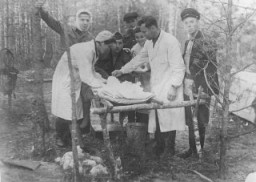
A young man in the Jewish quarter of Paris wears the mandatory Jewish badge. Paris, France, after June 1942.
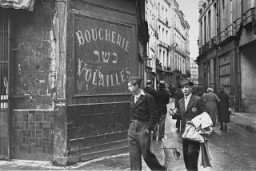
Jewish partisan and poet Abba Kovner, a survivor of the Vilna ghetto, testifies during Adolf Eichmann's trial. Jerusalem, Israel, May 4, 1961.
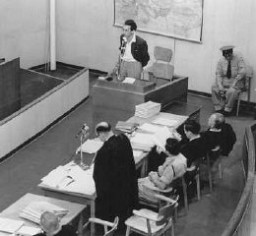
Former Jewish partisan leader Abba Kovner testifies for the prosecution during the trial of Adolf Eichmann. May 4, 1961.
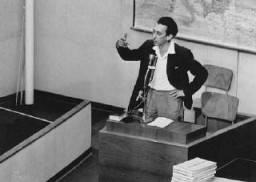
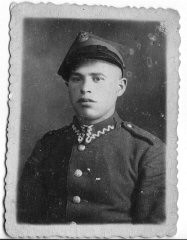
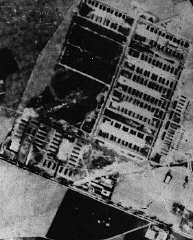
Abraham Blum, leader of the Bund (Jewish Socialist party) and member of the Jewish Fighting Organization (ZOB). Blum participated in the Warsaw ghetto uprising. Poland, between 1940 and 1943.
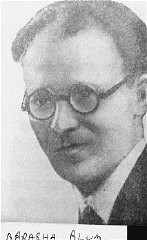
Abraham Lewenson testifying at the trial of Adolf Eichmann. Jerusalem, Israel, June 2, 1961. The Eichmann trial created international interest, bringing Nazi atrocities to the forefront of world news. Testimonies of Holocaust survivors generated interest in Jewish resistance. The trial prompted a new openness in Israel as the country confronted this traumatic chapter.
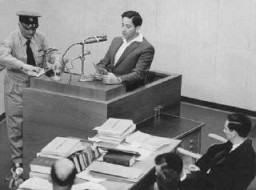
Abraham Morgenstern, right, stands in front of a sign marking the entrance to Bari Transit displaced persons (DP) camp in Italy, circa July 1947.
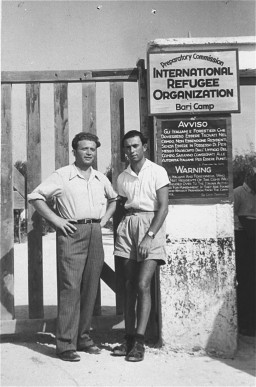
View of a camp for Soviet prisoners of war, showing the holes dug into the ground that served as shelter. The camp was located south of Hamburg in northern Germany. Wietzendorf, Germany, 1941–42.
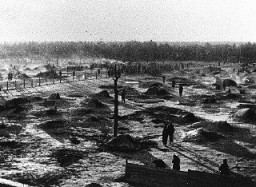
Reproduction of the first page of an addendum to the Reich Citizenship Law of September 15, 1935. This is the first of 13 addenda to the original legislation that were issued from November 1935 to July 1943 in order to implement the policy aims of the Reich Citizenship Law.
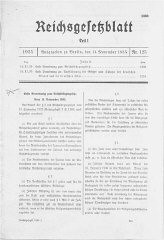
Adolf Eichmann, SS official in charge of deporting European Jewry. Germany, 1943.

Adolf Eichmann, SS official in charge of deporting European Jewry. Germany, 1940.
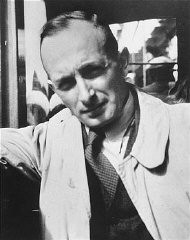
During his trial, defendant Adolf Eichmann reads a chart outlining the administrative hierarchy of the German Third Reich. Jerusalem, Israel. June 27 1961.
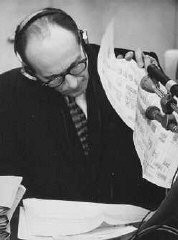
We would like to thank Crown Family Philanthropies, Abe and Ida Cooper Foundation, the Claims Conference, EVZ, and BMF for supporting the ongoing work to create content and resources for the Holocaust Encyclopedia. View the list of donor acknowledgement.